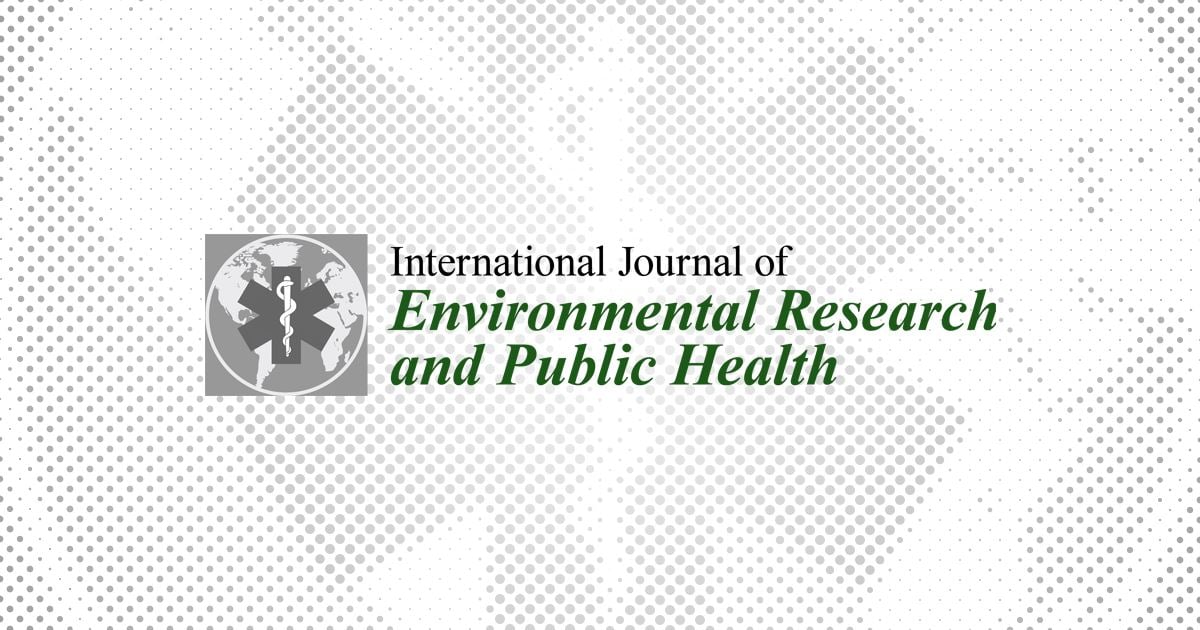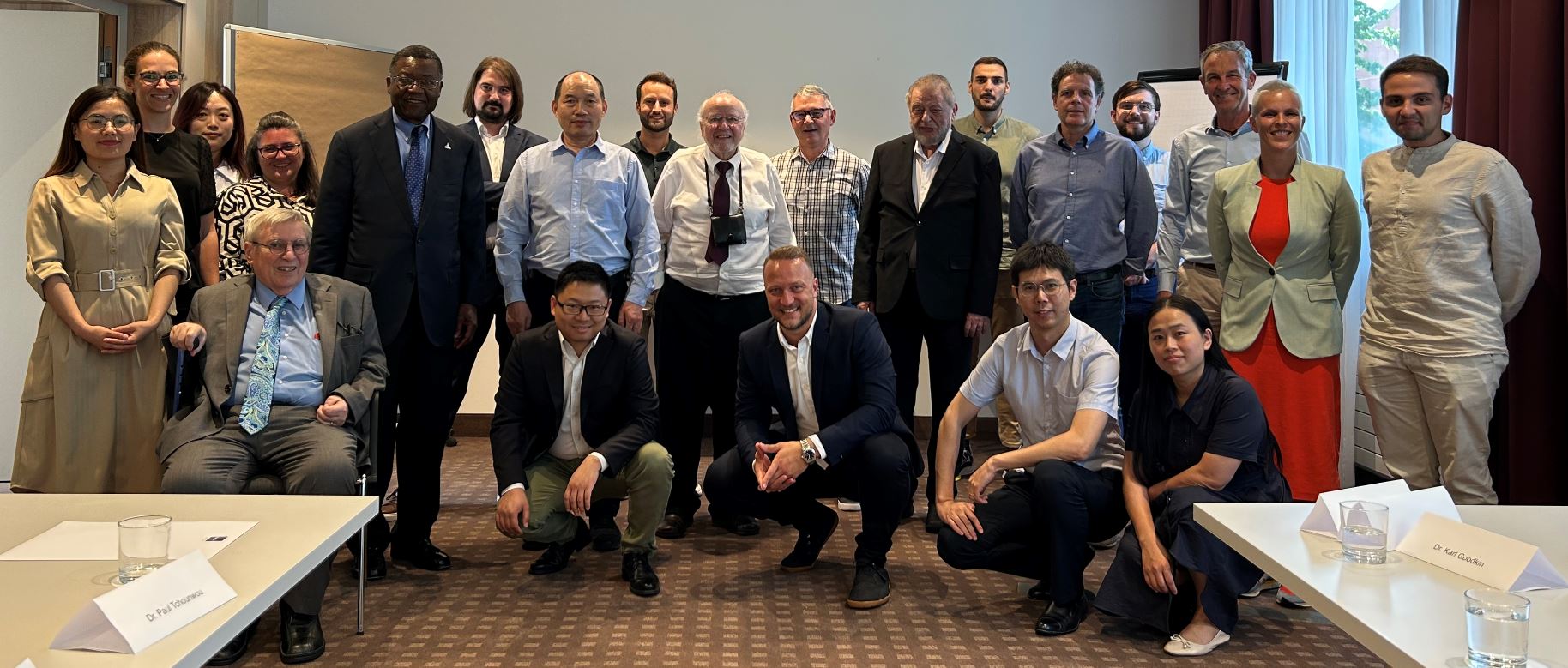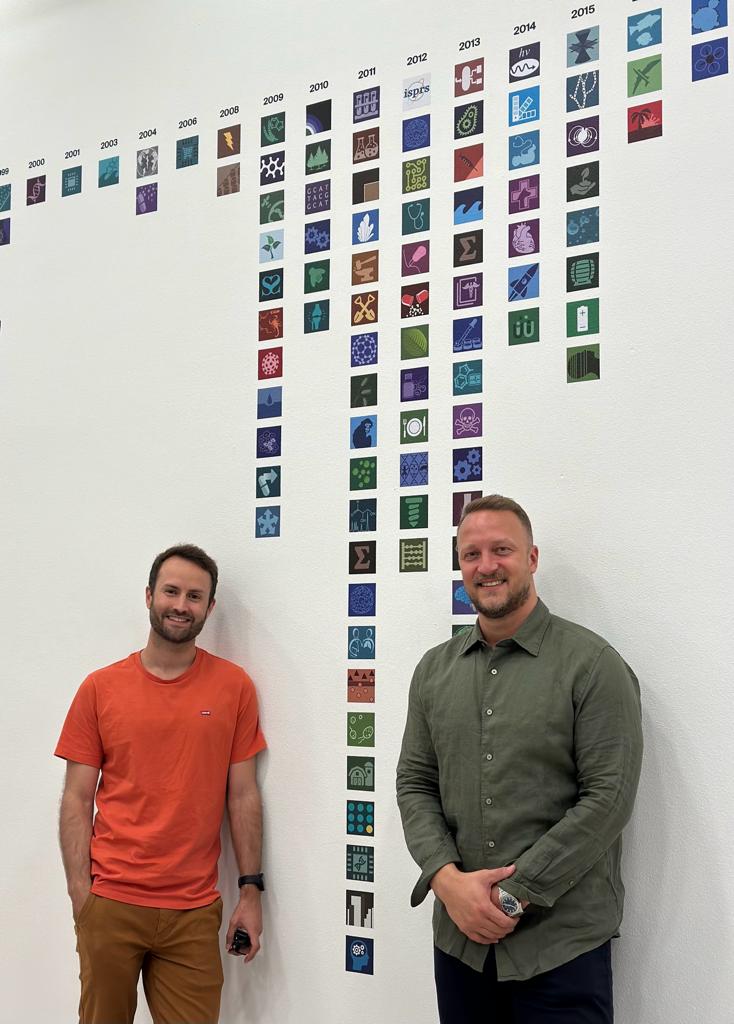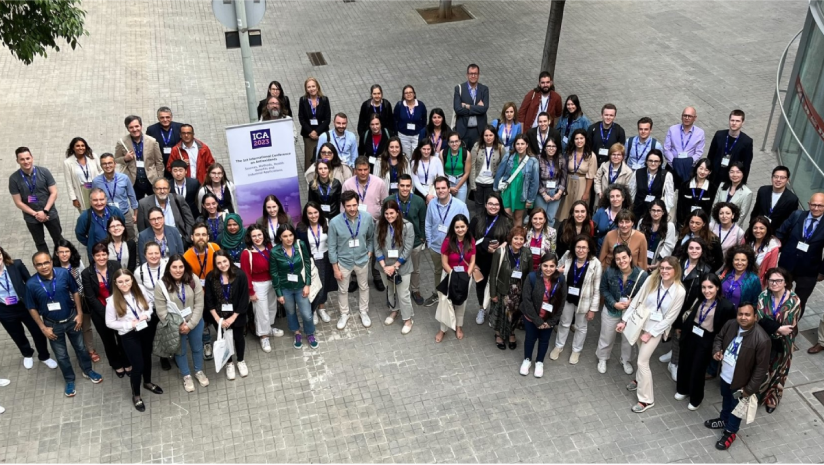
Journal Menu
► ▼ Journal Menu-
- Tomography Home
- Aims & Scope
- Editorial Board
- Reviewer Board
- Topical Advisory Panel
- Instructions for Authors
- Special Issues
- Topics
- Sections
- Article Processing Charge
- Indexing & Archiving
- Editor’s Choice Articles
- Most Cited & Viewed
- Journal Statistics
- Journal History
- Journal Awards
- Conferences
- Editorial Office
- 10th Anniversary
Journal Browser
► ▼ Journal BrowserNeed Help?
Announcements
18 August 2023
MDPI’s 2022 Travel Awards in Medicine and Pharmacology—Winners Announced

We are proud to recognize the winners of MDPI’s 2022 Travel Awards in medicine and pharmacology category for their outstanding presentations.
MDPI journals regularly offer Travel Awards to encourage talented junior scientists to present their research at academic conferences in specific fields, which helps to enhance their influence.
The winners mentioned below were carefully selected by the journal editors based on an outline of their research and the work to be presented at an academic conference.
We would like to congratulate the winners of the 2022 Travel Awards and wish them success with their future research endeavors. MDPI will continue to enhance communication among scientists.
- Filip Jansåker, Lund University, Lund, Sweden
- Vanessa Silva, University of Trás-os-Montes and Alto Douro, Portugal
- Diego de Miguel Perez, Icahn School of Medicine at Mount Sinai, USA
- Luigi Russo, Italian Institute of Technology (IIT), Italy
- Sneha Sethi, University of Adelaide, Australia
- Xiyin Wang, Indiana University School of Medicine, USA
- Sonia Nath, University of Adelaide, Australia
- Konstantina Kritikou, Carol Davila University of Medicine and Pharmacy, Romania
- Adrien Holzgreve, The University Hospital of Munich, Germany
- Antonella Padella, Istituto Romagnolo per lo Studio dei Tumori "Dino Amadori" - IRST S.r.l., Italy
- Susanna Cooper, St. George’s University of London, UK
- Renée Tillie, Maastricht University Medical Center, the Netherlands
- Max Lennart Eckstein, University of Bayreuth, Germany
- Lorenzo Bertani, University of Pisa, Italy
- Yuxue Cao, University of Queensland, Australia
- Flávia Sousa, Italian Institute of Technology, Italy
About MDPI Awards:
In order to support the academic community, especially young researchers, and enhance communication among scientists, MDPI journals regularly offer various awards to researchers in specific fields. These awards, serving as a source of inspiration and form ot recognition, help to promote the influence of talented individuals who have made outstanding achievements and are making significant contributions to their fields.
See more MDPI awards, please click here.
18 August 2023
MDPI’s 2022 Outstanding Reviewer Awards in Medicine and Pharmacology—Winners Announced

In order to acknowledge our reviewers, who so generously dedicate their time to reviewing papers and demonstrate diligence, professionalism, and timeliness when reviewing manuscripts, MDPI journals regularly offer outstanding reviewer awards to scholars who participate in the peer-review process.
We are proud to recognize the winners for the year 2022 in medicine and pharmacology for their outstanding contributions among the extensive competition by presenting them with an Outstanding Reviewer Award.
We would like to take this opportunity to congratulate all of the winners on their achievements. MDPI will continue to provide support and recognition to the academic community.
- Maxime Pichon, Centre Hospitalier Universitaire de Poitiers, France
- Violeta Popovici, Ovidius University of Constanta, Romania
- Yosra A. Helmy, University of Kentucky, USA
- Antonio G. Solimando, Aldo Moro University of Bari, Italy
- Linlin Guo, The Ohio State University Medical Center, USA
- Ravindra Deshpande, Wake Forest School of Medicine, USA
- Songli Zhu, Fred Hutchinson Cancer Research Center, USA
- Antonella Argentiero, IRCCS Istituto Tumori “Giovanni Paolo II” of Bari, Italy
- Camelia Coada, Alma Mater Studiorum-University of Bologna, Italy
- Chenghui Li, University of Arkansas for Medical Sciences, USA
- Laurentiu Pop, University of Texas Southwestern Medical Center, USA
- Muhammad Fazal Ijaz, Dongguk University, Republic of Korea
- Rafał Watrowski, University of Freiburg, Germany
- Ruben C. Petreaca, The Ohio State University, USA
- Ruchi Roy, Rush University Medical Center, USA
- Salvatore Cocuzza, University of Catania, Italy
- Santosh Kumar Singh, Morehouse School of Medicine, USA
- Sergei Boichuk, Kazan State Medical University, Russia
- Simon John Christoph Soerensen, Stanford University, USA
- Takuya Koie, Gifu University, Japan
- Teresa Rubio-Tomás, Foundation for Research and Technology Hellas, Greece
- Teruki Nii, Kyushu University, Japan
- Tomasz Marjanski, Medical University of Gdansk, Poland
- Kristen Haase, The University of British Columbia, Canada
- Ravi Ramjeesingh, Nova Scotia Cancer Centre and Dalhousie University, Canada
- Makoto Endo, Kyushu University, Japan
- Tefera Tadesse, Addis Ababa University, Ethiopia
- Ravi Ramjeesingh, Nova Scotia Cancer Centre and Dalhousie University, Canada
- Ryuichi Ohta, Unnan City Hospital, Japan
- Henry Sutanto, Cardiovascular Research Institute Maastricht, the Netherlands
- José-María Sánchez-González, University of Seville, Spain
- Emmanouil Kapetanakis, General Hospital of Piraeus “Tzaneio”, Greece
- Eleonora Topino, Libera Università Maria Santissima Assunta (LUMSA), Italy
- Rodolfo Reda, Sapienza University of Rome, Italy
- Giulio Francesco Romiti, Sapienza University of Rome, Italy
- Maria Gabriella Melchiorre, IRCCS INRCA—National Institute of Health and Science on Ageing, Italy
- James Walter, 1Hines VA Hospital, USA; 2 Loyola Medical Center, USA
- Vasiliki Tsigkou, Sotiria Hospital, Greece
- Flavia Zacconi, Pontificia Universidad Católica de Chile, Chile
- Bhupendra Prajapati, Ganpat University, India
- Van-An Duong, Gachon University, Republic of Korea
- Ashish Agrawal, Indian Institute of Technology (BHU), India
- Aydin Eresen, University of California Irvine, USA
About MDPI Awards:
In order to support the academic community, especially young researchers, and enhance communication among scientists, MDPI journals regularly offer various awards to researchers in specific fields. These awards, serving as a source of inspiration and form of recognition, help to promote the influence of talented individuals who have made outstanding achievements and are making significant contributions to their fields.
See more MDPI awards, please click here.
18 August 2023
MDPI’s 2022 Best PhD Thesis Awards in Medicine and Pharmacology—Winners Announced

MDPI’s Best PhD Thesis Awards aim to recognize young scholars who are deemed to have produced the most outstanding PhD thesis in their fields of research and to encourage them to continue their outstanding work and further contributions to their field.
We would like to congratulate the winners of the 2022 Best PhD Thesis Awards in medicine and pharmacology and wish them success with their future research endeavors. MDPI will continue to enhance communication among scientists.
- “Uncovering Novel Prognostic and Predictive Epigenetic Biomarkers in Malignant Testicular Germ Cell Tumors”
by João Pedro da Silva Machado Lobo, University of Porto, Portugal
- “Metastatic Recurrence in Colorectal Cancer Arises from Residual EMP1+ Cells”
by Adrià Cañellas Socias, University of Barcelona, Spain
- “Investigating Novel Aspects of the Blood–Brain Barrier Using High-Resolution Electron Microscopy”
by Shireen Mentor, University of Cape Town, South Africa
- “An Epidemiological Approach to Study The Interplay between Genome, Epigenome and Exposome in Women”
by Roberta Magnano San Lio, University of Catania, Italy
- “Intravitreal Liposomes as Ocular Drug Delivery Systems: Vitreal Interactions, Retinal Permeation and Drug Release Characteristics”
by Shirin Tavakoli, University of Helsinki, Finland
- “Microbiome-Mediated Colonization Resistance: Defense against Enteropathogens and Multi-Drug Resistant Organisms”
by Quinten Ducarmon, Leiden University Medical Center, the Netherlands
About MDPI Awards:
In order to support the academic community, especially young researchers, and enhance communication among scientists, MDPI journals offer various awards to researchers in specific fields. These awards, serving as a source of inspiration and form of recognition, help to promote the influence of talented individuals who have made outstanding achievements and are making significant contributions to their fields.
For more MDPI awards, please click here.
18 August 2023
MDPI’s Best Paper Awards in Medicine and Pharmacology—Winners Announced in 2022

The purpose of our Best Paper Awards is to promote and recognize the most impactful contributions published within MDPI journals.
The editors of each journal carefully selected review and research papers through a rigorous evaluative process based on criteria such as the scientific merit, overall impact, and quality of presentation of the papers published in the journal.
We are honored to present the winners for the year 2022 in medicine and pharmacology, who were selected amongst extensive competition, and congratulate the authors for their outstanding scientific publications. MDPI will continue to provide support and recognition to the academic community.
- “Development and Challenges of Antimicrobial Peptides for Therapeutic Applications”
by Charles H. Chen and Timothy K. Lu
Antibiotics 2020, 9(1), 24; https://doi.org/10.3390/antibiotics9010024
- “Antimicrobial Usage and Resistance in Companion Animals: A Cross-Sectional Study in Three European Countries”
by Philip Joosten, Daniela Ceccarelli, Evelien Odent, Steven Sarrazin, Haitske Graveland, Liese Van Gompel, Antonio Battisti, Andrea Caprioli, Alessia Franco, Jaap A. Wagenaar et al.
Antibiotics 2020, 9(2), 87; https://doi.org/10.3390/antibiotics9020087
- “Management of Peri-Implantitis Lesions without the Use of Systemic Antibiotics: A Systematic Review”
by Ahsen Khan, Ankit Goyal, Scott D. Currell and Dileep Sharma
Dent. J. 2020, 8(3), 106; https://doi.org/10.3390/dj8030106
- “Associations among Primary Stability, Histomorphometric Findings, and Bone Density: A Prospective Randomized Study after Alveolar Ridge Preservation with a Collagen Cone”
by Sigmar Schnutenhaus, Werner Götz, Jens Dreyhaupt, Heike Rudolph, Ralph G. Luthardt and Cornelia Edelmann
Dent. J. 2020, 8(4), 112; https://doi.org/10.3390/dj8040112
- “Novel Prefrontal Synthesis Intervention Improves Language in Children with Autism”
by Andrey Vyshedskiy, Edward Khokhlovich, Rita Dunn, Alexander Faisman, Jonah Elgart, Lisa Lokshina, Yuriy Gankin, Simone Ostrovsky, Lauren deTorres, Stephen M. Edelson et al.
Healthcare 2020, 8(4), 566; https://doi.org/10.3390/healthcare8040566
- “The Effects of Long-Term 40-Hz Physioacoustic Vibrations on Motor Impairments in Parkinson’s Disease: A Double-Blinded Randomized Control Trial”
by Abdullah Mosabbir, Quincy J. Almeida and Heidi Ahonen
Healthcare 2020, 8(2), 113; https://doi.org/10.3390/healthcare8020113
- “Racial Disparities-Associated COVID-19 Mortality among Minority Populations in the US”
by Donald J. Alcendor
J. Clin. Med. 2020, 9(8), 2442; https://doi.org/10.3390/jcm9082442
- “Hypertension, Thrombosis, Kidney Failure, and Diabetes: Is COVID-19 an Endothelial Disease? A Comprehensive Evaluation of Clinical and Basic Evidence”
by Celestino Sardu, Jessica Gambardella, Marco Bruno Morelli, Xujun Wang, Raffaele Marfella and Gaetano Santulli
J. Clin. Med. 2020, 9(5), 1417; https://doi.org/10.3390/jcm9051417
- “Estimation of the Transmission Risk of the 2019-nCoy and Its Implication for Public Health Interventions”
by Biao Tang, Xia Wang, Qian Li, Nicola Luigi Bragazzi, Sanyi Tang, Yanni Xiao and Jianhong Wu
J. Clin. Med. 2020, 9(2), 462; https://doi.org/10.3390/jcm9020462
- “Molecular and Cellular Mechanisms Affected in ALS”
by Laura Le Gall, Ekene Anakor, Owen Connolly, Udaya G. Vijayakumar, William J. Duddy and Stephanie Duguez
J. Pers. Med. 2020, 10(3), 101; https://doi.org/10.3390/jpm10030101
- “Postulated Adjuvant Therapeutic Strategies for COVID-19”
by Anderson O. Ferreira, Hudson C. Polonini and Eli C. F. Dijkers
J. Pers. Med. 2020, 10(3), 80; https://doi.org/10.3390/jpm10030080
- “Evidences of CTLA-4 and PD-1 Blocking Agents-Induced Cardiotoxicity in Cellular and Preclinical Models”
by Vincenzo Quagliariello, Margherita Passariello, Domenica Rea, Antonio Barbieri, Martina Iovine, Annamaria Bonelli, Antonietta Caronna, Gerardo Botti, Claudia De Lorenzo and Nicola Maurea
J. Pers. Med. 2020, 10(4), 179; https://doi.org/10.3390/jpm10040179
- "Manufacturing Considerations for the Development of Lipid Nanoparticles Using Microfluidics”
by Carla B. Roces, Gustavo Lou, Nikita Jain, Suraj Abraham, Anitha Thomas, Gavin W. Halbert and Yvonne Perrie
Pharmaceutics 2020, 12(11), 1095; https://doi.org/10.3390/pharmaceutics12111095
- “Development of Remdesivir as a Dry Powder for Inhalation by Thin Film Freezing”
by Sawittree Sahakijpijarn, Chaeho Moon, John J. Koleng, Dale J. Christensen and Robert O. Williams III
Pharmaceutics 2020, 12(11), 1002; https://doi.org/10.3390/pharmaceutics12111002
- “Skin Wound Healing Process and New Emerging Technologies for Skin Wound Care and Regeneration”
by Erika Maria Tottoli, Rossella Dorati, Ida Genta, Enrica Chiesa, Silvia Pisani and Bice Conti
Pharmaceutics 2020, 12(8), 735; https://doi.org/10.3390/pharmaceutics12080735
- “The Role of Hospital and Community Pharmacists in the Management of COVID-19: Towards an Expanded Definition of the Roles, Responsibilities, and Duties of the Pharmacist”
by Nicola Luigi Bragazzi, Muhammad Mansour, Alessandro Bonsignore and Rosagemma Ciliberti
Pharmacy 2020, 8(3), 140; https://doi.org/10.3390/pharmacy8030140
- “Association of a Novel Medication Risk Score with Adverse Drug Events and Other Pertinent Outcomes Among Participants of the Programs of All-Inclusive Care for the Elderly”
by David L. Bankes, Hubert Jin, Stephanie Finnel, Veronique Michaud, Calvin H. Knowlton, Jacques Turgeon and Alan Stein
Pharmacy 2020, 8(2), 87; doi.org/10.3390/pharmacy8020087
About MDPI Awards:
In order to support the academic community, especially young researchers, and enhance communication among scientists, MDPI journals regularly offer various awards to researchers in specific fields. These awards, serving as a source of inspiration and form of recognition, help to promote the influence of talented individuals who have made outstanding achievements and are making significant contributions to their fields.
See more MDPI awards, please click here.
7 August 2023
Tomography | Aims and Scope Update
We are pleased to announce that Tomography (ISSN: 2379-139X) held a successful meeting with the journal’s Editorial Board Members on 29 June 2023, chaired by Editor-in-Chief Prof. Dr. Emilio Quaia. With the Editorial Board Members’ suggestion and for the better development of Tomography in the future, we adjusted the aims and scope of Tomography, which are outlined below.
Aims and Scope
Mission statement: Tomography (ISSN: 2379-139X) publishes peer-reviewed original articles spanning all aspects of (bio)medical imaging in healthcare and life biological science including microscopy, ranging from basic research to clinical science, clinical applications, and innovations in imaging data science, as well as artificial intelligence.
Topics of interest: Topics of interest include the advancement of (bio)medical imaging technologies across multiple scales in space and time, including cross-sectional imaging modalities (for example: US, CT, MRI, and PET), as well as other imaging modalities (for example, bioluminescence, photoacoustic, optical and electronic microscopy, optical imaging, cryo-electron microscopy, fiber optic imaging, and optical computed tomography). Original articles on advances in biomedical imaging hardware and software, novel imaging contrast mechanisms and agents, imaging informatics, imaging analysis, and AI applications in biomedical imaging, as well as on chemical and molecular probe developments are welcome.
For more journal information, please check the following link: https://www.mdpi.com/journal/tomography/about.
27 July 2023
MDPI Insights: The CEO's Letter #2 - Open Peer-Review and IJERPH

Welcome to the MDPI Insights: The CEO's Letter.
In these monthly letters, I will showcase two key aspects of our work at MDPI: our commitment to empowering researchers and our determination to facilitating open scientific exchange.
Opening Thoughts

Open Peer Review Reports
Continuing the topic of openness from my inaugural monthly CEO letter, in these Opening Thoughts, I highlight the growth and importance of open peer-review reports at MDPI. Open peer reports align with the principles of open science, making the publishing process more transparent and facilitating rigorous peer review.
MDPI journals operate an open peer-review option by default, allowing authors to publish review reports and author responses (often referred to as open reports) together with the published paper. Publishing the reviewer reports and author responses together with the article provides greater transparency and trust for readers, as this allows them to track the editorial decision-making process. Open peer-review also encourages reviewers and editors to provide high-quality comments, as these will be made public if the article is accepted for publication.
Start and Growth of Open Peer Review at MDPI
The MDPI journal Life was a pioneer in offering this opportunity to its authors in 2014. The first MDPI article with peer-review reports openly published was a review by the Nobel Laureate Werner Arber, in which the review reports were published as supplementary material. By 2018, open peer-review was available across all MDPI journals. As such, MDPI authors have embraced the open peer-review model, providing a steady increase in the number of MDPI articles. As of 2023, approximately one-third (34.0%) of MDPI articles were published with open review reports.
As at July 2023, the percentage of MDPI articles published with open peer review has increased to 36.2% of the total papers published in 2023 so far, indicating ongoing growth in adoption.
Open peer review continues to play a critical role in the assessment of the peer-review process in Life. For further insights, please see the recent editorial by Dr. Pabulo Henrique Rampelotto, the former Editor-in-Chief of Life, who spearheaded the implementation of the open peer-review process.
Benefits of Open Peer Review
The benefits of open peer review include increased transparency, trust and constructive feedback. To promote open communication further and increase the robustness of the peer-review process, we encourage reviewers to sign their reports so that their name appears on the review report (this process is referred to as open identity). The default option is for reviewers to remain anonymous; however, by signing the reports, reviewers receive direct credit for their contribution to the peer-review process and show their commitment towards open science.
As the leading open access publisher, MDPI remains committed to promoting open peer-review and encourages authors to choose this approach. Our goal is to provide a rigorous and transparent peer-review process that benefits the scientific community, and we believe that open peer-review is a vital step in fostering openness and collaboration in scientific communication.
Impactful Research

MDPI Papers Cited in the News – IJERPH edition
Every month, our corporate marketing team compiles data from Altmetrics to create a list of MDPI papers that have been cited in the news. This list continues to grow as renowned news outlets regularly reference research published by MDPI in their articles.
During 2022, a total of 111,965 MDPI research papers were mentioned in prominent news outlets such as National Geographic, The Washington Post, Forbes, The Guardian, the BBC, CNN, Time, and Harvard Business Review.
Highly Cited Journal Publications
IJERPH, known for publishing impactful research, received the most news mentions among all MDPI journals in 2022, based on Altmetrics data:
- International Journal of Environmental Research and Public Health: 3509 mentions
- Nutrients: 2698 mentions
- International Journal of Molecular Sciences: 1701 mentions
- Journal of Clinical Medicine: 1131 mentions
- Viruses: 1111 mentions
These numbers show the recognition and impact of the articles published in IJERPH. For a more detailed view of the journal’s most cited and viewed papers, you can visit here. In total, IJERPH has garnered over 28,000 mentions in prominent news outlets, and as at July 2023, an impressive count of over 17,000 papers cited 10 times or more. These figures highlight the impactful contribution of IJERPH publications to the scientific community.
Example of Recent Mentions
During May and June 2023, a noteworthy selection of articles from IJERPH was cited in news articles, including:
The Washington Post: “Bringing nature inside can improve your health. Here’s how to do it.”
IJERPH paper: “Physiological Benefits of Viewing Nature: A Systematic Review of Indoor Experiments”
Harvard Business Review: “How to Take Better Breaks at Work, According to Research”
IJERPH paper: “Canine-Assisted Therapy Improves Well-Being in Nurses”
National Geographic: “Lyme disease is spreading fast—but a vaccine may be on the way”
IJERPH paper: “Range Expansion of Tick Disease Vectors in North America: Implications for Spread of Tick-Borne Disease”
Inside MDPI

MDPI Develops an Artificial Intelligence Tool to Enhance the Peer-Review Process
At MDPI, we believe that rigorous peer-review is the corner-stone of high-quality academic publishing. We are grateful to the scholars who generously dedicate their time to peer-review articles submitted to MDPI journals. Their contributions are invaluable to the advancement of science.
Peer-review is a critical part of the publication process, ensuring that MDPI upholds the highest quality standards for the papers we publish. Every manuscript submitted to our journals undergoes a comprehensive peer-review process conducted by subject-matter experts.
To further enhance our peer-review process, our Data Analytics team has developed an Artificial Intelligence (AI) tool designed to support the selection of reviewers. This proprietary tool utilizes Natural Language Processing (NLP), a specially designed AI language model, to extract information from the title and abstract of submitted papers. It then searches our database for similar manuscripts and suggests potential reviewers based on this analysis. Integrated with MDPI's submission system (SuSy), the AI tool cross-references the suggested candidates with our reviewer database to verify their invitation status and availability.
The goal of this tool is to provide better targeted peer-review invitations, reducing the number of emails sent for each paper and increasing the efficiency of our editorial staff.
In the near future, our Data Analytics team plans to deploy similar AI projects to improve other critical aspects of our services, offering an enhanced experience to our authors and readers.
Click here to learn about MDPI’s review process, including procedures, responsibilities, and benefits.
Read more:
Coming Together for Science
The Future of IJERPH

On 5 July 2023, Prof. Dr. Paul B. Tchounwou, the founding Editor-in-Chief of IJERPH, along with five Section Editors in Chief (Prof. Dr. Germán Vicente-Rodríguez, Prof. Dr. Karl Goodkin, Prof. Dr. William A. Toscano, Prof. Dr. Jimmy T. Efird, and Prof. Dr. William Douglas Evans), gathered in Basel to discuss the future of the journal. The meeting provided an opportunity to address the recent decision by The Web of Science to delist IJERPH due to the journal failing the Content Relevance criterion, and propose best strategies that will ensure high scientific rigor as well as a clear scope and aim of IJERPH, going forward.
While the delisting is disappointing for IJERPH, as well as for our authors, academic editors, and the entire scientific community supporting our journal, we see it as an opportunity to reflect and prepare for the future direction of the journal.
Since its launch in 2004, IJERPH’s vision and mission have evolved to be more complete and comprehensive in engaging scientific communities. In light of this, we will refresh the journal’s aims and scope, ensuring they align with the organic expansion of IJERPH. Additionally, we will restructure the journal sections into broader categories, encouraging collaborative research and transdisciplinary approaches for authors. This is designed to foster collaboration and knowledge exchange among diverse fields, contributing to a holistic understanding of health promotion and disease prevention. We are confident that these next steps will enhance the scientific strength and societal impact of our journal.

Journal Achievements
In addition to the productive discussions, we took the time to celebrate some of the remarkable achievements of IJERPH, which I highlight below:
- Founded by Prof. Dr. Paul B. Tchounwou in 2004
- Indexed in PubMed in 2008
- Received its first Impact Factor in 2012
- Published its 5000th paper in 2017
- Over 60,000 papers published as at June 30, 2023
- 131,628,173 paper views in 2018–2022
- Over 28,000 mentions in prominent news outlets
- 17,000 papers cited 10 times or more as at June 30, 2023
- No.1 journal in the 2022 Google Scholar Metrics in the category of Public Health
- Awarded several editions of Young Investigator Awards, Travel Awards, and Outstanding Reviewer Awards since 2018.
These achievements showcase the journal’s significant contributions to the field and its impact on global health. We are proud of the exceptional work accomplished by the IJERPH team and look forward to building upon this success in the years to come.
Closing Thoughts
MDPI’s Impact in Spain

During the past month, I had the opportunity to visit our new office building in Barcelona, where I met with our local colleagues to discuss the ways we serve the scholarly community, particularly in Spain. The multi-functional office plays a vital role in supporting various business needs, including editorial, design, conference management, data analytics, journal relationship management, publishing partnerships, and collaborations with societies.
Spain holds a significant position in MDPI’s global market, ranking as the fourth-largest contributor to the total number of papers published by MDPI as at July 2023, ranking next to Italy, the USA, and China, with Germany completing the top five.
The Numbers
Out of the 1,680,000 total MDPI articles published as at 25 July, almost 80,000 articles are contributed by Spanish authors, representing nearly 40,000 unique authors affiliated with Spanish institutions. Remarkably, over 6,300 of these authors hold editorial board member (EBM) positions within MDPI journals, with 30 of them serving as Editors-in-Chief (EiCs).
Our commitment to working with institutions is very evident in Spain, where we have successfully established over 40 Institutional Open Access Programs (IOAP) with esteemed institutions such as the University of Barcelona, the Autonomous University of Barcelona, Pompeu Fabra University, the University of Navarre, and Complutense University of Madrid.
Over the past five years, we have successfully organized eight in-person conferences in Barcelona, attracting over 1,150 registrations, with two forthcoming events scheduled for 2024. Barcelona's excellent connectivity to international airports makes it easily accessible to participants from around the world. Its welcoming atmosphere provides us with the perfect environment for knowledge-sharing, networking, and contributing to the local economy.
Our growth and presence in Spain are a true testament to the incredible service we provide to the scholarly community and the relationships we foster through responsive and collaborative communication. We look forward to continuing to support Spanish scholars, providing them a valuable and trusted experience with MDPI, the leader in open access publishing.
Testimonials
I close this letter as I did in the first edition, by sharing testimonials from our stakeholders. Here are a few IJERPH testimonials from a Spanish guest editor and an author:
Guest Editor
“I want to thank the kindness, attention and professionalism of the MDPI team throughout the editorial process of the Special Issue. I believe that it is a very professional and quality editorial process.”
- Professor Víctor Arufe-Giráldez, University of A Coruña
Special Issue in International Journal of Environmental Research and Public Health: Physical Activity in Childhood and Adolescence
Special Issue in International Journal of Environmental Research and Public Health: Physical Education: Present and Future
__
Author
“I want to thank the rigor of the revisions made to the manuscripts to improve their quality, the support to the authors for the editor assignment system they have and the follow-up they carry out, for the speed in answering and in carrying out the entire process of the revision, and for doing all this at an affordable price.”
- Dr. María Paz García-Caro, University of Granada
Article in International Journal of Environmental Research and Public Health: Factors Associated with Suicide Attempts and Suicides in the General Population of Andalusia (Spain)
Chief Executive Officer
MDPI AG
11 July 2023
MDPI’s Newly Launched Journals in June 2023
With the first issue released in June 2023, five new MDPI journals disseminating multi-disciplinary science are due to launch, which will cover the subjects of medicine & pharmacology, biology and physical sciences.
The newly launched journals will be overseen by professional Editorial Board Members and Editors to ensure an accurate and rapid publication, rigorous peer review and broad visibility.
Please feel free to browse and discover more about the new journals below.
| Journal | Founding Editor-in-Chief | Journal topics (selected) |
| Prof. Dr. Jun Ma, Peking University, China| Editorial | view inaugural issue | growth and development; diet and nutrients; school health promotion policies and practices; child health and care; adolescent health and wellbeing | view journal scope | submit an article |
|
| Prof. Dr. Bernd Rehm, Griffith University, Australia | Editorial | view inaugural issue | DNA and gene synthesis; synthetic transcription factors; protein engineering; viral engineering; metabolic engineering | view journal scope | submit an article | |
| Prof. Dr. Varsha Gandhi, University of Texas MD Anderson Cancer Center, USA | Editorial | view inaugural issue | lymphatics; cancers associated with lymphocytes and lymphoblasts; lymphatic tissues; lymphoma; lymphoid leukemia | view journal scope | submit an article | |
| Dr. Bradley Turner, University of Melbourne, Australia | Editorial | view inaugural issue | multiple sclerosis; amyotrophic lateral sclerosis; primary lateral sclerosis; atherosclerosis; systemic sclerosis | view journal scope | submit an article | |
 |
Prof. Dr. Clemens Burda, Case Western Reserve University, USA | Editorial | view inaugural issue | Gamma ray, X-ray, and UV–Vis spectroscopies; NIR/mid-infrared/Raman spectroscopy; microwave and THz spectroscopy; high-resolution gas-phase atomic, molecular, and cluster spectroscopy; MS, NMR, and EPR spectroscopy | view journal scope | submit an article |
We wish to thank everyone who has supported the development of open access publishing. You are welcome to submit an application to the New Journal Committee (newjournal-committee@mdpi.com) if you would like to create more new journals.
5 July 2023
Prof. Dr. Pascal N. Tyrrell Appointed Section Editor-in-Chief of Section “Artificial Intelligence in Medical Imaging” in Tomography
We are pleased to announce that Prof. Dr. Pascal N. Tyrrell has been appointed Section Editor-in-Chief of the “Artificial Intelligence in Medical Imaging” Section in Tomography (IF: 1.9, ISSN: 2379-139X).

Name: Prof. Dr. Pascal N. Tyrrell
Affiliation:
1. Department of Medical Imaging, University of Toronto, Toronto, ON M5T 1W7, Canada;
2. Department of Statistical Sciences, University of Toronto, Toronto, ON M5T 1W7, Canada;
3. Institute of Medical Science, University of Toronto, Toronto, ON M5T 1W7, Canada.
Interests: artificial Intelligence; biostatistics; machine learning; medical images
Website: https://medical-imaging.utoronto.ca/faculty/pascal-tyrrell
The following is a short Q&A with Prof. Dr. Pascal N. Tyrrell, who shared his vision for the journal with us, as well as his views of the research area and open access publishing:
1. What appealed to you about Tomography that made you want to take the role as its Section Editor-in-Chief?
The aims and scope of our journal Tomography fit my area of research perfectly! I also enjoy the fact that the journal includes both imaging and optical modalities which provides ample opportunity for cross-pollination in this interesting area of science.
2. What is your vision for the Section?
I think artificial intelligence is an inevitable technological advance that will provide incredible progress in all areas of research and development it is applied to. As a journal, we should get out in front of these advances in order to contribute and be a part of the change that is happening in the field of tomography.
3. What does the future of this field of research look like?
The future of AI in tomography is bright. What an exciting time for scientists! Be prepared for a tsunami of impactful AI research applications.
4. What do you think of the development of open access in publishing?
Open access publishing’s main advantage is free access to scientific literature (especially for researchers in developing countries) resulting in a wider readership. The biggest challenge, of course, is quality control. If done right, open access publishing will contribute to the democratization of science in a sustainable way.
We look forward to Prof. Dr. Pascal N. Tyrrell’s contribution to the continued success of the journal.
4 July 2023
Welcoming New Editorial Board Members of Tomography
We are pleased to announce that four new scholars were appointed Editorial Board Members (EBMs) of Tomography (ISSN: 2379-139X) in May 2023. We wish our new members success in both their research and the development of the journal.
|
Name |
Affiliation |
|
Prof. Dr. Cristian T. Badea |
Duke University Medical Center, USA |
|
Prof. Dr. Eric Sigmund |
NYU Langone Medical Center, USA |
|
Prof. Dr. Michael T. McMahon |
Kennedy Krieger Institute, USA |
|
Dr. Sumit Isharwal |
University of Virginia Health System, USA |
Further details about the Editorial Board can be found at the following link: https://www.mdpi.com/journal/tomography/editors.
Tomography is recruiting prestigious scholars from around the world to join our Editorial Board. To apply for this position, recommend potential candidates, or request further information, please contact the Tomography Editorial Office (tomography@mdpi.com) with the following two files attached:
- A full academic CV;
- A short cover letter that details your interest in and enthusiasm for the position.
Tomography Editorial Office
3 July 2023
MDPI Insights: The CEO's Letter #1 - Open Access and Impactful Research

Welcome to the MDPI Insights: The CEO's Letter.
In these monthly letters, I will showcase two key aspects of our work at MDPI: our commitment to empowering researchers and our determination to facilitating open scientific exchange.
Opening Thoughts
The Future is Open, and MDPI is Leading the Way
I strongly believe in a future that embraces openness, where open source, open information, and open access (OA) take center stage. This belief that led me to join MDPI in 2020, and I am honored to have recently been appointed as Chief Executive Officer (CEO). In this capacity, and operating in close liaison with Dr. Lin and MDPI’s senior management, I shall work to build on Dr. Lin’s achievements of the past quarter-century. In this role, I will focus on communication initiatives to promote MDPI's remarkable work and continue to build our company as a trusted leader in OA publishing. For over two decades, MDPI has been at the forefront of reshaping the academic publishing landscape, with OA surpassing subscription-based publishing in 2020. This trajectory is deeply rooted in our history and reflects our unwavering commitment and vision for an open future.
1 Million Published Articles
2023 began with a remarkable achievement for MDPI, as we became the first OA publisher to reach the milestone of 1 million published articles. This represents 2.7 million unique authors who have trusted us with their work, or about a third of all researchers worldwide. As the world's most cited OA publisher, we are proud in sharing these significant milestones.
Our mission remains unchanged: to make science open and accessible to all. We understand the importance of knowledge access, empowering researchers to stay at the forefront of a rapidly changing world. Our diverse range of journals covers a wide spectrum of disciplines, offering cutting-edge insights, trusted tools, and crucial knowledge to address global challenges.
Liberating Science
As the world’s leading OA publisher, MDPI is actively liberating science. We are committed to eliminating the frustrations researchers and the general public face when accessing information, ensuring it is not locked behind paywalls. We firmly believe that everyone has a right to information, and our commitment to open access publishing drives our work.
In this inaugural edition of Insights: The CEO's Letter, I draw inspiration from the upcoming 20th anniversary of the Berlin Declaration on Open Access. Its stated mission reminds us that true impact is achieved when knowledge is widely and readily available to society:
"Our mission of disseminating knowledge is only half complete if the information is not made widely and readily available to society”
Impactful Research

MDPI Publishes Impactful Research: Recognized by Leading Indexing Databases
MDPI journals are indexed in every single top database in the world.
As of June 2023, we have 214 journals indexed within Web of Science, 223 indexed within Scopus, 87 indexed within PubMed and PMC, and 17 indexed within MEDLINE, and these numbers increase every month. We constantly strive to expand the coverage of our journals within leading multi-disciplinary and scope-specific databases, resulting in an incredibly broad range of journals that are indexed within a variety of databases. MDPI has active relationships with approximately 65 well-known databases around the world, and we continue to expand our portfolio every year so that your work can be found, cited, and referenced with ease.
Continued Growth of MDPI Journals
The 2022 Scopus and Web of Science journal citation metrics were officially released in June, and I am pleased to report that 31 MDPI journals received their first CiteScore, taking the total number of journals with a CiteScore to 216. The number of MDPI journals receiving an Impact Factor (IF) also continues to grow with 111 receiving their first, by being covered in the ESCI, bringing our total number of journals with an IF to 208 of which 41 journals received an IF above 4.0. Looking at 2022 CiteScores in the Scopus database, 80% of MDPI journals have a score that ranks them in Q1 or Q2 in at least one subject category.
Publishing impactful science would not be possible without all of our authors, editors and reviewers. Thank you for your contribution and continued support! Together we share the latest scientific insights faster and ensure that your work is accessible to all.
Read more
Inside MDPI

Preprints.org: Clarivate adds the Preprint Citation Index to the Web of Science
At MDPI, we are dedicated to driving the advancement of science. Through our initiative, Preprints.org, researchers can publish their work and gain valuable feedback from the broader research community, ensuring rapid progress in their respective fields. This is particularly crucial during times of health and climate challenges, where timely dissemination of findings is essential.
Increased Visibility for Preprints
I am pleased to share that Clarivate recognizes the significance of preprints and has taken a crucial step to enhance their visibility. Clarivate has added the Preprint Citation Index to the Web of Science, encompassing preprints published not only on Preprints.org but also on other reputable repositories.
Looking ahead, the future of preprints appears promising, bolstered by the recent indexing announcement from the Web of Science. As a result, preprints will receive increased visibility, serving as a valuable resource for staying informed about the latest research developments.
Read more
What are Preprints?
The Pros and Cons of Preprints
Preprints and COVID-19
Preprints—The Future of Open Access Publishing?
Coming Together for Science

The First International Conference on Antioxidants: Sources, Methods, Health Benefits and Industrial Applications
In this edition of ‘Coming Together for Science,’ I am pleased to highlight the First International Conference on Antioxidants organized by our conference team in the beautiful city of Barcelona, Spain. The conference attracted over 130 attendees, who engaged in 42 talks, and 89 poster presentations spread across several sessions.
Working Together
Under the leadership of Prof. Dr. Alessandra Napolitano (Department of Chemical Sciences, University of Naples ‘Federico II’, Naples, Italy) and Prof. Dr. Rosa M. Lamuela Raventos (Department of Nutrition, Food Sciences and Gastronomy, University of Barcelona, Spain) as chairs, and supported by the committee members, 10 invited keynote speakers, poster presenters, and all the attendees, this dedicated group of academics came together to discuss the natural sources, methodologies, health benefits, and industrial applications of antioxidants.
Especially noteworthy is the positive feedback received from attendees, with 94% rating the overall organization of the conference as good or excellent. I particularly love the picture above, capturing the gathering of some of the participants. You can browse through more photos in the event gallery located here.
Managing Events With Sciforum
If you are considering hosting your own academic event, I highly recommend checking out Sciforum, MDPI's event management platform. Sciforum simplifies the entire process, making it easy to host your own event by allowing you to focus on what really matters: Science!
Read more
Closing Thoughts
 Stefan Tochev, Dr. Shu-Kun Lin, Dr. Eric O. Freed, Peter Roth, Wynne Wang, Allison Yang
Stefan Tochev, Dr. Shu-Kun Lin, Dr. Eric O. Freed, Peter Roth, Wynne Wang, Allison Yang
Viruses and Editorial Quality: Acknowledging the Dedication of our Viruses Journal Team
During a June meeting with Dr. Eric O. Freed, the founding and current Editor-in-Chief of our journal Viruses, I was reminded of the exceptional dedication of our editorial board. Meeting with Eric is a pleasure, as he has a strong commitment and clear vision for the journal. Over the course of two days, we gained a deep understanding of the journal’s expectations and focus on strategic growth, editorial board representation, and engagement.
I am pleased to share that Viruses holds a CiteScore of 7.1 (an increase of 7.57% versus the 2021 metric) and an Impact Factor of 4.7. You can view the journal statistics here. Viruses publishes highly cited papers, and is indexed in renowned databases such as Scopus, SCIE (Web of Science), PubMed, and others, and maintains affiliations with prestigious societies. Moreover, the Viruses team has recently announced an exciting upcoming event titled ‘Viruses 2024 – A World of Viruses,’ scheduled to take place in Barcelona, Spain, from 14–16 February 2024.
Testimonials
If you notice my enthusiasm regarding our editorial service, it’s because the surveys and testimonials we receive speak volumes about the experiences of our authors, reviewers, and guest editors who collaborate with MDPI. The purpose of these letters is to highlight the exceptional work that we do and the experiences we create for the scholars – thus, let me end with this testimonial from an author:
“It was a great pleasure to publish in Viruses Special Issue [Emerging Viruses in Aquaculture]. The submission process was easy. Guest editors were very helpful and provided all the guidance and support as needed. The handling of the manuscript by the Editorial Team was very fast, efficient, and professional. The reviewer’s comments were insightful, and the publication processes were remarkably rapid.”
– Ms. Magdalena Stachnik, Państwowy Instytut Weterynaryjny | PIWet
Article in Viruses: Emerging Viral Pathogens in Sturgeon Aquaculture in Poland: Focus on Herpesviruses and Mimivirus Detection
Chief Executive Officer
MDPI AG




